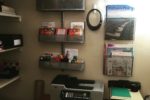Vintage PA: Change, Change, Change
In my capacity as QOTS (you had to be there- if not, see my Essential Skills Series) I quite often need to be the instigator of radical change in my students. When interviewing transfer students in my private studio, we discuss both the student’s and my goals for their musical studies. I feel that this discussion is a critical part of the decision making process as they choose a teacher to guide them forward.
At the college, however, I am the only piano teacher. When I meet with students for the first time, they play for me and we discuss our goals just as with my private students. But, that general piano class or private piano student doesn’t have a choice in teacher—they get me by default.
With pre-college and adult students in the private studio there is most always time to integrate change slowly according to the individual’s need vs. their capacity for the new. In fact that is one of the basic precepts of planning lessons. But what happens when you know you will only have a student for 2 or less years? It crimps your style- that’s what!
Here a few thoughts on setting priorities to implement change when your time together is limited.
- Just as in the food industry there are critical and non critical violations. Habits (reading and playing) that lead to tension and physical injury are critical. Consistently whacking the ends of phrases? Annoying but perhaps not so critical in the great scheme of things.
- Ethics and just being the good, kind, and loving people that we are, forbids us to directly criticize or say anything which might be construed as belittling a student’s former teacher. Instead, talk about the work needed as building on what that teacher has given to the student. If the student is self taught, then praise them for the enormous effort and good work they have done to get to where they are now. One caveat here; there have been times, (including one recent one involving raising the fingers high above the bridge then and lowering each as hard and fast as possible while playing Hanon) in which I have been forced to tell a student straight out that I disagreed with their former teacher.
- Be ready for unpleasant surprises—even after an interview that includes sight reading, playing, rhythm, technical, and musicianship skills. A really gifted student and I were recently shocked and surprised to discover that her rhythmic subdivision skills were built on sand. We had to discuss it frankly and take steps in order for her to successfully play her chamber music piece. Stuff happens!
- Work together to build a new toolbox filled with alternate techniques and strategies. I have found the musical toolbox to be a non-threatening way to talk about change. It rarely conjures up defensiveness. Once the new alternate tools are integrated into a student’s playing, they will nearly always choose ease, comfort, and beautiful tone over their former habits and discard the old tool on their own.
- Limit the number of changes you are asking for to 1 or 2 and refine as you go. Add the most basic skills first and then build on them. Grit your teeth and bear any others for the time being. Building on new skills is important because a student needs to use each skill in varied situations in order to own it. A student of mine who was very stiff wanted very badly to play Beethoven’s Pathetique. The pitfalls were many for her. We had been working on a stable hand and wrist flexibility with gesture layered in for 3 semesters with incremental progress. Against my better judgment I said, “Why not?” Creating the dramatic fortes in the opening allowed her to truly know that her hand was firm and stable enough to take on the weight of her entire body. She didn’t need to be stiff anymore and there was a dramatic opening up in all of her playing. Why not indeed…
- Know that part of what you are teaching is the ability to change. Whether you work on rotation, wrist flexibility, practice strategies, 2 note slurs, or firm fingers and an arched bridge, if the student really implements it into their learning and playing, the foundation has been laid for further refinement. The student has not only gained a new tool, but has gained the ability to be open to change—to seek out ways to add to their toolbox. This is a gift you can give even during a single semester.
This vintage post was previously published in April of 2011



